
After the Exeter conference my holiday proper began. I travelled by train down to Cornwall, to Truro where I made my base for the next few days. Truro is the county seat, though it’s not a big town by any means. (Nowhere in Cornwall is, which is part of its charm.) It does have the Royal Cornwall Museum, which I looked through on my first morning there. Among the Roman coins and old coaches is the so-called Arthur stone, which was found at Tintagel Castle — which is where I went in the afternoon.

Tintagel is a ruined 13th century castle on a windswept promontory which juts into an equally windswept sea.

The castle was built by Richard of Cornwall on the site of an older fortress.
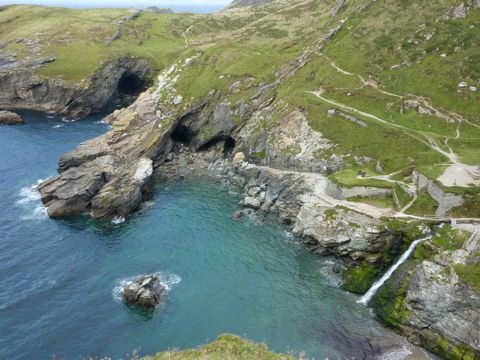
In the 5th or 6th centuries, the fortress here guarded this little cove, which must have been busy: a large quantity of fine Mediterranean pottery has been found at Tintagel (more than anywhere else in Britain), indicating that it belonged to somebody rich and powerful.
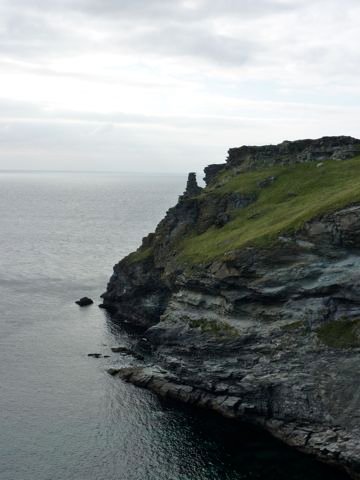
Even earlier, in late Roman times, there was a hill fort here.

But none of that explains why so many tourists (including me!) visit Tintagel Castle.

The real reason is the Arthurian connection. Depending on who you listen to, Tintagel was where Merlin lived, where Arthur was conceived, where he was born, where Tristan and Iseult had their affair. Not that there is any shortage of such potential sites, but the importance of Tintagel was championed by such influential Arthurians as Geoffrey of Monmouth. Indeed, Richard of Cornwall apparently built his castle here precisely to evoke memories of Arthur, and did so in a conspicuously old-fashioned style.
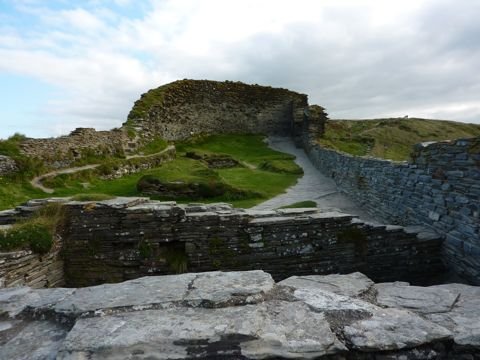
I’ve long had an interest in Arthur. Even though I guess that was inspired by repeat viewings of the John Boorman film Excalibur, I’ve mostly focused on the historical Arthur, not the mythical one.

Where there’s smoke, there’s fire. There’s enough relatively early textual evidence of the existence of a British military leader called Arthur, who played a major role in fighting the Saxon invaders in the 6th century or so. While his precise history can never be recovered now, there’s nothing implausible about the existent of such a figure. So why not accept that he probably did exist?

Or so I thought before reading N. J. Higham’s King Arthur: Myth-making and History (London and New York: Routledge, 2002). It completely turned me around on the subject! Higham shows that all the early mentions (and frustrating near-mentions, such as by Gildas) to Arthur are completely explicable in terms of the political context of the times in which they were written, as well with reference to earlier texts such as the Bible.

For example, the Historia Brittonum, traditionally attributed to Nennius, can be shown to have been written to support the political and dynastic claims of Merfyn, king of Gwynedd in north Wales in the 9th century. It’s not a history as we understand it, but an account designed to show that providence (i.e. God) ruled the fate of nations. It argues against the earlier work of Gildas, which portrayed the Britons as a people who had forfeited their claim to be God’s new chosen race, which was of great propaganda value for the (now Christian) Anglo-Saxon kingdoms pressing in from the west (see the venerable Bede). Higham’s close reading of the Historia shows it heavily constructed Arthur as a secular counterpart to St Patrick and as a British counterpart to Joshua (a victorious war leader who was never a king). It’s so heavily constructed that there is no reason to believe that the fragments of detail the Historia gives about Arthur has any basis in any earlier (‘authentic’) tradition. So the debates over how Arthur’s description as dux bellorum fits in with the nature of kingship in the 6th and 7th centuries, for example, are beside the point: the Old Testament was the inspiration for this title.

And that’s one of the very earliest mentions of Arthur. The later you get, the less chance of any kernel of truth being preserved by some lucky oral or textual survival anyway; and Higham deals with these in similar fashion. There may be smoke, but it’s so thick that we can’t actually tell if there ever was a fire.

I have to admit that this was all a bit disappointing. But the history and archaeology of the British kingdoms is still fascinating and I’ll keep reading about it. And there’s still the Arthurian legends to enjoy. And there’ll always be Excalibur!

What else can I say about Tintagel? The less said about the village itself the better, really. It’s got some very tacky shops which have names with extra Es on the end, and somehow had far more tourists in it than the castle itself, even though it’s about the only reason to visit. (Above is the pretty awful Camelot Castle Hotel, on the cliffs overlooking Tintagel Castle.)
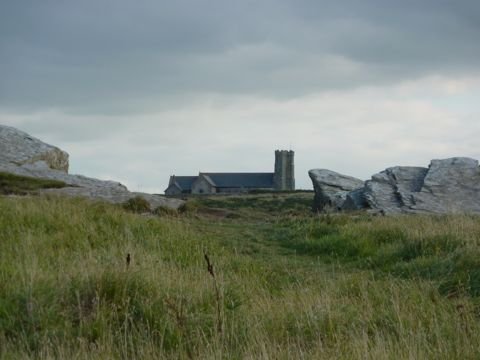
Though there is also the parish church, devoted to St Materiana, which might have been built as early as the late 11th century.

And which I didn’t have time to see, except from afar.

The views were indeed quite stunning.

I was glad to be near the sea; last time I visited the UK I didn’t get much closer to it than Calton Hill.

Though I must say the water didn’t look very inviting!
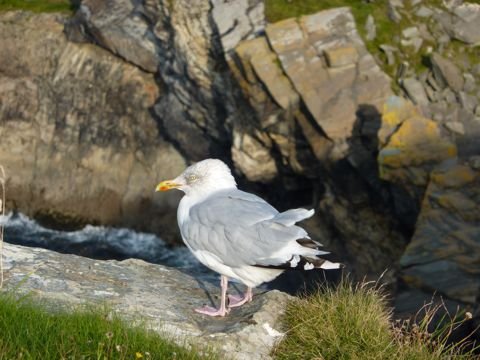
This is, um, a bird of some sort. A sea bird. (I do aeroplanes, not avians!)

Merlin’s Cave looking one way …

… and the other.

On my way back to Truro from Tintagel I had my first (and, luckily, my only) major transport snafu of the whole trip. I had to change buses at nearby Camelford, and I knew I’d be catching the last one (it being just out of season, this was about 6.30pm). But it never turned up! Or if it did, I wasn’t there at the right time or the right place. So I had to find an inn for the night. I can recommend the Darlington Inn if you ever find yourself stuck in Camelford after hours :)
Camelford itself has been supposed by some to be the site of Camelot, and nearby Slaughterbridge the site of Camlann, Arthur’s final battle. But as I’ve dispatched Arthur once already, I’ll let him rest in peace.
![]() This work is licensed under a Creative Commons Attribution-NonCommercial-NoDerivatives 4.0 International License.
Permissions beyond the scope of this license may be available at http://airminded.org/copyright/.
This work is licensed under a Creative Commons Attribution-NonCommercial-NoDerivatives 4.0 International License.
Permissions beyond the scope of this license may be available at http://airminded.org/copyright/.

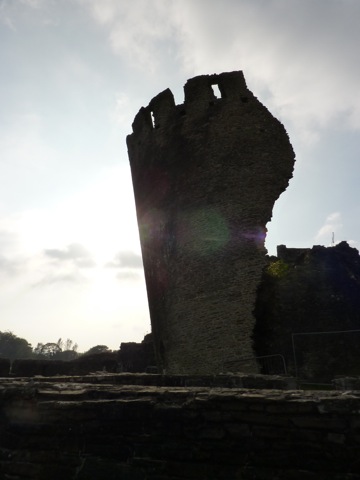
Now why can’t I live somewhere with a fantastic name like Slaughterbridge?
Study those birds, and you’ll learn that aviation is just a great illusion!
Don’t compromise on Slaughterbridge, when you can have Lower, Upper or Middle Wallop, Piddletrenthythe or Long Load. I lived in Middleton Stoney for a while, which is a long way from Stoney Middleton, if people were careless of the addresses. There are many more, even greater enjoyment can be obtained by adding the naive American (even if mythic) tourist element.
The very charismatic Michael Wood’s TV programme on Arthur in his ‘In Search of Myths & Legends’ series is very good as a look at the legends, the ‘realities’ and as you’ve touched on Brett, the need for re-inventing myths for new political purposes. A good jog trot through the complexities of the Artherian stories. Of course, on a basic level, if a story has a clear need to exist and feels ‘right’ in the way that Arthur does, the historian alarm bells should sound max volume…
See, Australia has many places with names imported directly or indirectly from Britain, but for some reason we don’t tend to pick ones like Slaughterbridge or Middle Wallop (or Westward Ho!), despite having no aversion to silly place names. There are exceptions, though. I used to live in Footscray, which is named after Foots Cray, a charmingly odd name.
I was also in Tintagel briefly during September (24th) – the first time I’d been there since a visit with my then-gf in the summer of 1977. I went on a day trip from Somerset, first going to Teignmouth (home of Muse) via a village – while we’re on evocative names – called Starcross, then across Dartmoor.
There are relatively few visitors to Tintagel itself compared to the tacky village for probably the same reason there are relatively few people walking round the top of Cheddar Gorge (my regular Sunday walk) compared with Cheddar village below – its actually pretty steep and tough to get about on. There’s a Land Rover shuttle for the more infirm or lazy the half-mile or so down to the entrance, but after that its a lot of steep wooden steps.
We have some other good names in Somerset, like Shepton Mallet, Chew Magna and Westonzoyland, next to the last battle on English soil, the Battle of Sedgemoor. And, to be relevant to this blog, site of an RAF base 1926-68
True, it is a bit of a climb. But then that answer leads to the question, why not go somewhere where it’s easier to get around? Eh, it’s not my time and money I suppose.
Starcross is a good name. I’d call my village Starcross, if I had one.
Pingback: Falmouth